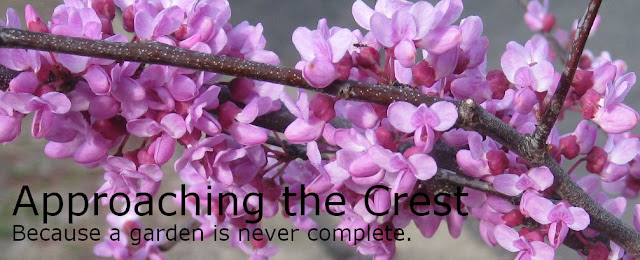Here's today's harvest:
 | |
| un-processed gazpaho |
1. The garlic, obviously, was not harvested today. It wasn't even grown by me (my first gazpacho failure of the year: my garlic didn't bulb), but given to me by a friend.
2. See those nearly-black peppers? They're the first carnival peppers I've picked this season
3. Where'd that cucumber come from? Didn't I rip out my monstrous volunteer last week? Yes, yes I did. But I have another volunteer, growing up the other side of the trellis arch. This is the second of three cukes it has produced so far. It won't get to 35, but it is making up for slow production with quality. This cuke picture might just be the tastiest cucumber I've ever eaten (and those other 35 were pretty darn good). I'm not kidding.
4. I tried growing onions this year, without success. And my chives in a pot got rather dried up this summer; they're just starting to come back (you can see two little bits I snipped off, resting on the garlic). So instead of my usual onion and chive ingredients, I'm using the green and white parts of some bunching onions, pictured.
5. That's not nearly enough tomatoes for gazpacho. Fortunately I have a friend with excess.
6. I forgot to plant chervil this year (in fact, I've never planted chervil). So the herb mix in today's gazpacho is basil, parsley, green onion (in place of chives), and tarragon.
How do I turn that into gazpacho? I use a recipe I developed many years ago after a wonderfully yummy trip to Spain (where, in Sevilla, I tasted my first gazpacho: I was hooked). Upon my return home, I visited the local library (the interwebs weren't the bountiful resource of modern days) and checked out every book with a gazpacho recipe. I could tell that none of the recipes was going to give me what I had tasted in Andalusia, but I was able to pull elements from this one and that one to get a pretty close approximation to what I wanted. I've been using this recipe ever since.
Here's the basic recipe, with notes:
In a food processor, combine and process the herbs (about 1/2 cup packed. My herb mix gets closer to a cup) and a clove or two of garlic. Add 1/2 c olive oil and 1/4 c red vinegar (full disclosure: I don't ever expect these to come from my garden) and process. Add peeled, seeded, cored, chopped veggies (a small onion, 1/2 cucumber, the equivalent of a large bell pepper, and the equivalent of 4 large tomatoes). (Another disclosure: I no longer go through the extra steps of peeling and seeding the tomatoes. It's not worth it). Process until evenly lumpy. Add up to 3c of tomato juice and process to mix (at this point I have to take the soup out of the processor, and put it in a bowl with an immersion blender - my food processor isn't large enough to handle the full amount).
Serve garnished with chopped veggies and optional hard-boiled egg pieces (something else that will never come from my garden).











































